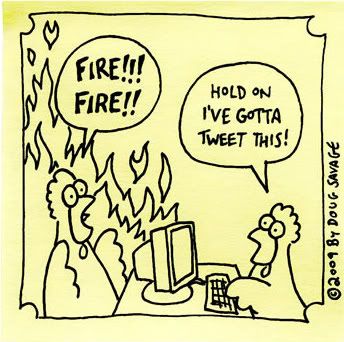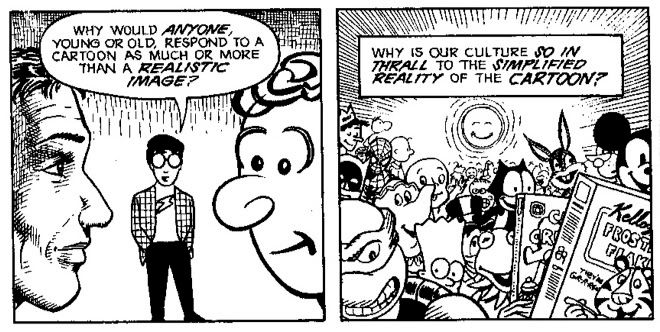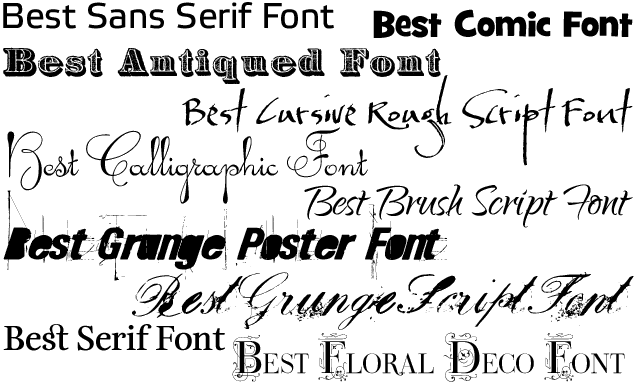
Survival. As naturalist Charles Darwin described, "It is not the strongest of the species that survives, nor the most intelligent that survives. It is the one that is the most adaptable to change." This statement is as true today as it was over a century ago. The need to survive is biologically programmed into our very being. In recent years, the concept of survival has taken on new meaning, as adapting to the rapid changes that accompany technological advances has become a type of survival onto itself. In the virtual world, to which admission is possible using a device capable of accessing the World Wide Web, digital survival can be accomplished by developing a web presence by joining any number of social networking sites. Social networking allows users to make and manage connections within an online community (Common Craft). According to a recent survey by Pew Internet, it would appear that over 45% of American adults who have internet access are members of some social networking site. Not everyone agrees with the significance of this recent trend. Some would question the importance, and even necessity, of survival in the digital realm. The above comic by cartoonist Doug Savage compares traditional physical survival to the emerging digital survival. The visual argument presented by this graphic requires viewers to consider if digital survival is as necessary as physical survival?
 When initially examining this comic, it is necessary to understand some basic conventions of reading comics in Western cultures. There is a single panel, which is the focal point framed by a square-shaped border. Within this boundary the discourse takes place in two forms--graphically and textually. According to Compose, Design, Advocate (CDA), "our attentions are almost always first directed to the ... illustrations--and only then to words" ( 301). The graphical depiction of two cartoon chickens that our eyes are drawn to seems humorous. Chickens would never naturally appear in a situation similar to the one depicted here. Even though the characters are chickens, readers of this comic can relate because of the anthropomorphic characteristics they are given. The chicken on the left represents the need for physical survival. He is postured with his beak open wide revealing his tongue, and his wings are held up in alarm perpendicular to the ground. When we combine the position of his body with the leaping flames behind him, we can interpret a situation where alarm is warranted. The chicken on the right represents the need for digital survival. He has been placed in front of a computer screen with his wings on the keyboard. We can relate to this desire to be connected through the internet, on some level at least, becuase over 74% of Americans use the internet (Internet World Stats). The simple situation depicted by the author is still familiar and pertinent, even when chickens are the characters.
When initially examining this comic, it is necessary to understand some basic conventions of reading comics in Western cultures. There is a single panel, which is the focal point framed by a square-shaped border. Within this boundary the discourse takes place in two forms--graphically and textually. According to Compose, Design, Advocate (CDA), "our attentions are almost always first directed to the ... illustrations--and only then to words" ( 301). The graphical depiction of two cartoon chickens that our eyes are drawn to seems humorous. Chickens would never naturally appear in a situation similar to the one depicted here. Even though the characters are chickens, readers of this comic can relate because of the anthropomorphic characteristics they are given. The chicken on the left represents the need for physical survival. He is postured with his beak open wide revealing his tongue, and his wings are held up in alarm perpendicular to the ground. When we combine the position of his body with the leaping flames behind him, we can interpret a situation where alarm is warranted. The chicken on the right represents the need for digital survival. He has been placed in front of a computer screen with his wings on the keyboard. We can relate to this desire to be connected through the internet, on some level at least, becuase over 74% of Americans use the internet (Internet World Stats). The simple situation depicted by the author is still familiar and pertinent, even when chickens are the characters.
 The chickens' actions and mannerisms are familiar because we assign meaning to them as we read and interpret the comic. As Scott McCloud explains in his essay The Vocabulary of Comics, humans have the ability to "see ourselves in everything ..." and also to "...assign identities and emotions where none exist" (204). We can see ourselves in the characters of this comic because we have bodies. This means that "our responses to ... illustrations depend[s] on our bodily and cultural experiences of the world" (CDA, 303). The abstract idea of chickens facing the dilemma of physical versus virtual survival is almost ludicrous, but this abstraction allows for what McCloud terms "amplification through simplification" (201). This means that the medium of cartoon will allow us to focus on specific ideas since we eliminate others during the process of cartooning. The idea of survival is boiled down to the simplest form as two types of survival--physical and digital--are represented. After noticing the characters of the comic strip, we notice the setting and other components of the panel. There are flames in the background that appear to be moving right. There is also a table that houses a computer screen and keyboard, which one of the characters uses. Besides these meager props, there is no background. Does this lack of background mirror the lack of interaction with the physical world that digital survival requires? According to an article by Information Week, internet use actually increases (real) social connectivity.
The chickens' actions and mannerisms are familiar because we assign meaning to them as we read and interpret the comic. As Scott McCloud explains in his essay The Vocabulary of Comics, humans have the ability to "see ourselves in everything ..." and also to "...assign identities and emotions where none exist" (204). We can see ourselves in the characters of this comic because we have bodies. This means that "our responses to ... illustrations depend[s] on our bodily and cultural experiences of the world" (CDA, 303). The abstract idea of chickens facing the dilemma of physical versus virtual survival is almost ludicrous, but this abstraction allows for what McCloud terms "amplification through simplification" (201). This means that the medium of cartoon will allow us to focus on specific ideas since we eliminate others during the process of cartooning. The idea of survival is boiled down to the simplest form as two types of survival--physical and digital--are represented. After noticing the characters of the comic strip, we notice the setting and other components of the panel. There are flames in the background that appear to be moving right. There is also a table that houses a computer screen and keyboard, which one of the characters uses. Besides these meager props, there is no background. Does this lack of background mirror the lack of interaction with the physical world that digital survival requires? According to an article by Information Week, internet use actually increases (real) social connectivity. After identifying graphical elements of the comic, we can now focus on the textual elements. Speech balloons appear above characters heads, and contain the "verbal" dialogue that is taking place in the comic. There is a pointed arrow coming from each balloon that shows which statement belongs to what character. The typography, or the arrangement and style of the text, also affects how the message is interpreted. The bold weight of the words "FIRE!!! FIRE!!!" coming from the chicken on the left create a contrast from the words of the chicken on the right. This choice of typeface provides a visual support of the importance of this chicken's message. Ultimately, the interaction between image and text is created to provide structure, or an appeal to logos, to the composition.
After identifying graphical elements of the comic, we can now focus on the textual elements. Speech balloons appear above characters heads, and contain the "verbal" dialogue that is taking place in the comic. There is a pointed arrow coming from each balloon that shows which statement belongs to what character. The typography, or the arrangement and style of the text, also affects how the message is interpreted. The bold weight of the words "FIRE!!! FIRE!!!" coming from the chicken on the left create a contrast from the words of the chicken on the right. This choice of typeface provides a visual support of the importance of this chicken's message. Ultimately, the interaction between image and text is created to provide structure, or an appeal to logos, to the composition.Works Cited
"Adults on Social Networking Sites, 2005-2009." Graph. Pew Internet and American Life Project. Accessed 9 Nov. 2009 from http://pewinternet.org/Infographics/Growth-in-Adult-SNS-Use-20052009.aspx.
"Charles Darwin." Wikipedia. Web. Accessed 9 Nov. 2009 from http://en.wikipedia.org/wiki/Charles_darwin.
"Internet Footprint." Wikipedia. Web. Accessed 9 Nov. 2009 from http://en.wikipedia.org/wiki/Internet_footprint.
"Charles Darwin." Wikipedia. Web. Accessed 9 Nov. 2009 from http://en.wikipedia.org/wiki/Charles_darwin.
Gonsalves, Antone . "Internet Use Increases Social Connectivity ." Information Week. 9 Nov. 2009. Web. Accessed 10 Nov. 2009 from http://www.informationweek.com/news/internet/social_network/showArticle.jhtml?articleID=221600719.
"Internet Footprint." Wikipedia. Web. Accessed 9 Nov. 2009 from http://en.wikipedia.org/wiki/Internet_footprint.
McCloud, Scott. "The Vocabulary of Comics." Print. Understanding Comics: The Invisible Art. Brattleboro: Harper Paperbacks, 1994.
"Social Networking in Plain English." Video. Common Craft. 2007. Accessed 9 Nov. 2009 from http://www.commoncraft.com/store-item/video-social-networking.
"United States Internet Usage Statistics." Internet Usage World Stats. Accessed 29 Oct. 2009, http://www.internetworldstats.com/am/us.htm.
"Visual Rhetoric/Visual Literacy: Writing About Comics and Graphic Novels." Print. Duke University Writing Studio. Accessed 9 Nov. 2009 from http://uwp.duke.edu/wstudio/.
Wysocki, Anne F., and Dennis A. Lynch. Compose, Design Advocate: A Rhetoric for Integreating Written, Visual, and Oral Communication. New York: Pearson Longman, 2007. Print.
No comments:
Post a Comment